- | Policy Briefs Policy Briefs
- |
Economic Freedom in the Period of Invisible Punishment: Occupational and Business Licensing Barriers That Restrict Access to Work for Those with Criminal Records
Revised August 2022
In the United States, once people have been convicted of a crime—or, in many cases, even arrested for a crime—those people are marked for life in a way that allows states to deny them the right to earn a living in the profession of their choosing. Instead of preparing those who have made mistakes for a productive return to society, the criminal justice system prepares them for a life of unemployment, underemployment, dependency, and, in many cases, stints in and out of jail.
Occupational and business licensing barriers are obviously harmful for those with criminal records and play a role in rates of recidivism. They also have wider adverse social consequences because
- in general, obtaining a job and staying employed is the most important way for formerly incarcerated individuals to pursue productive lives and experience a lower rate of recidivism;
- states with stricter occupational licensing requirements have higher rates of recidivism among those with criminal histories; and
- areas that have better employment and job opportunities tend to experience lower crime rates.
Modest, as well as more ambitious, reforms to occupational and business licensing can yield large returns by helping individuals with a criminal record pursue work opportunities that put them on a path toward productive reentry into society.
The US Incarceration Rate
For much of US history, the incarceration rate held steady at about 100 individuals per 100,000 residents. Then, beginning around 1970, the incarceration rate rose precipitously and continued to rise for the next three-and-a-half decades. That growth has tapered off over the past 15 years, so now there are about 629 incarcerated persons per 100,000 residents of all ages (see figure 1).
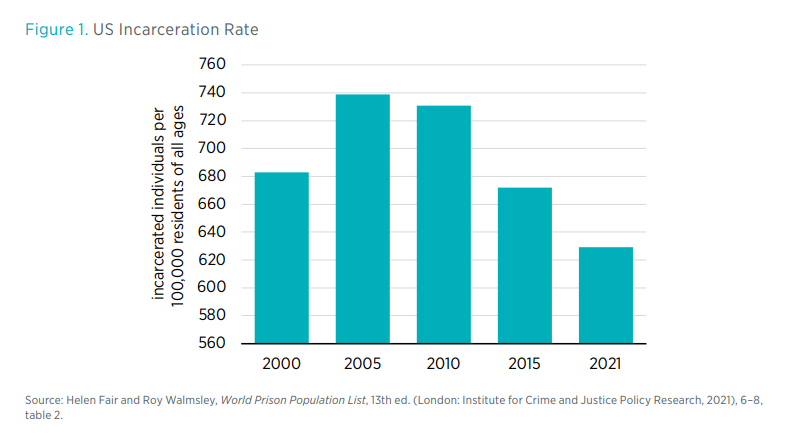
Still, the US incarceration rate is among the highest in the world. Among those countries that faithfully report their data, the United States incarcerates a higher share of its population than any other. Figure 2 shows the highest reported incarceration rates in the world, and figure 3 compares the US incarceration rate to that of select Western countries.

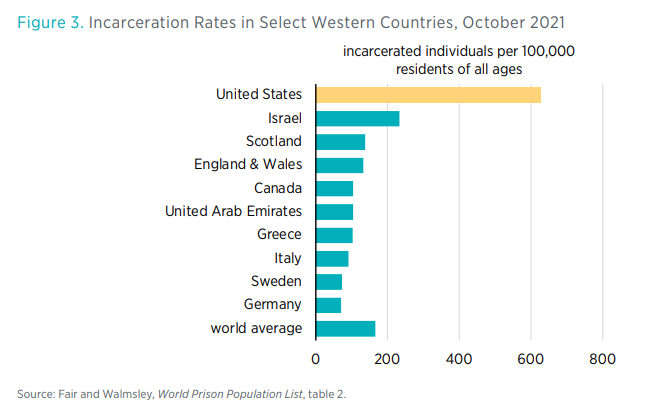
The “Mark” of a Criminal Record
In many ways the incarceration rate—the share of the population in prison or jail at any one time—dramatically understates the effect of the criminal justice system on the population, because once one steps outside of a jail cell, he or she enters what Jeremy Travis of the Urban Institute calls the “period of invisible punishment.” As Michelle Alexander explains in her book The New Jim Crow, this term
"is meant to describe the unique set of criminal sanctions that are imposed on individuals after they step outside the prison gates, a form of punishment that operates largely outside of public view and takes effect outside the traditional sentencing framework. These sanctions are imposed by operation of law rather than decisions of a sentencing judge, yet they often have a greater impact on one’s life course than the months or years one actually spends behind bars."
These sanctions include voting restrictions, limits on jury service, limits on government assistance, limits on immigration and travel, and—of particular concern for those attempting to reenter the workforce—limits on economic liberty. Consider the following examples:
Sonja Blake, a Wisconsin grandmother, had been running a daycare for nearly a decade when her daycare owner certificate was revoked and her occupational license stripped because 30 years earlier she had been found guilty of receiving $294 in public assistance overpayments.
Rudy Carey spent years battling drug and alcohol addiction, and during that time he made his share of mistakes. One mistake—assault—landed him in jail. In 2007, however, he turned his life around and wanted to help others do the same. So he completed hundreds of hours of coursework and training to become a substance abuse counselor. Five years into his career as a counselor in Fredericksburg, Virginia, the state sent his employer a letter stating that he was banned from counseling for life because of his 2004 conviction.
To address a critical shortage of firefighters, the state of California spent time and money training Dario Gurrola to fight fires while he was in custody. Though the state allows him to work as a seasonal firefighter, it categorically bans him from obtaining an EMT license to work year-round because he has two felony convictions. His crimes are now more than 15 years old, but he faces a lifetime ban during his period of invisible punishment.
The National Inventory of Collateral Consequences of Conviction, a database maintained by the American Bar Association and funded by the US Department of Justice, keeps tabs on these consequences. It reports that, nationwide, there are more than 16,000 limitations on “occupational and professional licensure and certification” for those who have been convicted of a crime. In addition, there are nearly 13,000 limitations on “business licensure and participation” for those with convictions. Taken together, there are over 25,000 barriers to employment for those who have been convicted of crimes (owing to overlap, it is not valid to simply add the occupational and business licensing burdens to arrive at a total).
For example, in Wisconsin, any felony conviction will automatically and indefinitely disqualify an aspiring barber from obtaining a barber’s license. Similarly, in the District of Columbia, a controlled substance offense gives the licensing board the discretion to indefinitely deny an applicant a general contractor’s license.
These limitations on economic freedom explain, in part, the considerable evidence that the mark of a criminal record reduces employment prospects. Those who have had contact with the criminal justice system are less likely to search for work. Contingent on searching for work, they are less likely to obtain a job. If they do obtain a job, they are less likely to retain it. And if they do retain it, they are less likely to work full time and are likely to earn less.
The problem is compounded by the fact that, although a small minority of Americans are incarcerated at any particular point in time, a staggeringly large share of Americans have been arrested or convicted of a crime at one point in their lives. According to a report from the Brennan Center for Justice, in 2017 there were 7.7 million formerly imprisoned people in the United States. Another 12.1 million had been convicted of felonies but did not serve time in prison, and another 46.8 million people had been convicted of misdemeanors. Thus, in total, about 66 million Americans—more than one in five—had a criminal record in 2017. Michelle Alexander notes that, unlike the currently incarcerated population, a large majority of those that have had contact with the criminal justice system are nonviolent offenders. More than three-quarters of those on community supervision, for example, were convicted of nonviolent crimes.
Overcriminalization is likely a significant contributing factor to the large share of Americans with criminal records. As Justice Neil Gorsuch recently put it, “In our own time and place, criminal laws have grown so exuberantly and come to cover so much previously innocent conduct that almost anyone can be arrested for something.” Indeed, it is estimated that by 2019, there were more than 5,000 crimes in the federal code and the number of statutes in the code with at least one crime had increased by 36 percent since 1994. Researchers suggest that perhaps 70 percent of Americans have committed an act in their life that could have left them with a criminal record had they been caught.
How Widespread Are Business and Occupational Licensing Restrictions for the Criminal Justice Population?
States can bar workers with a criminal record from obtaining a license to work or start a business in two main ways. One way used by many states is a blanket ban, which is a provision that specifically denies a license to applicants who have a criminal conviction. Another way is a provision that requires the applicant to have a “good moral character” or to lack “moral turpitude” to obtain the license, which gives licensing agencies broad discretion to reject individuals who have been arrested, even if those individuals were never convicted. This justification can be used by licensing agencies because having a criminal record can serve as sufficient evidence that an individual lacks good character. Sometimes these blanket bans or good-character provisions apply even when an applicant’s offense is long in the past or when the crime was unrelated to the profession for which the applicant seeks a license.
Although these bans can be time limited or conditional, some 16,000 limitations on licensure are indefinite, and nearly 9,000 restrictions specify a “mandatory disqualification,” meaning that licensing agencies are required to reject the license application. Figure 4 shows the types of offenses for which states bar business or occupational licensure. It shows, for example, that there are 10,160 restrictions on occupational and business licensure for individuals found guilty of a felony. Moreover, it shows that states impose more restrictions for those found guilty of misdemeanors and substance abuse crimes than for those found guilty of violent or sexual offenses.
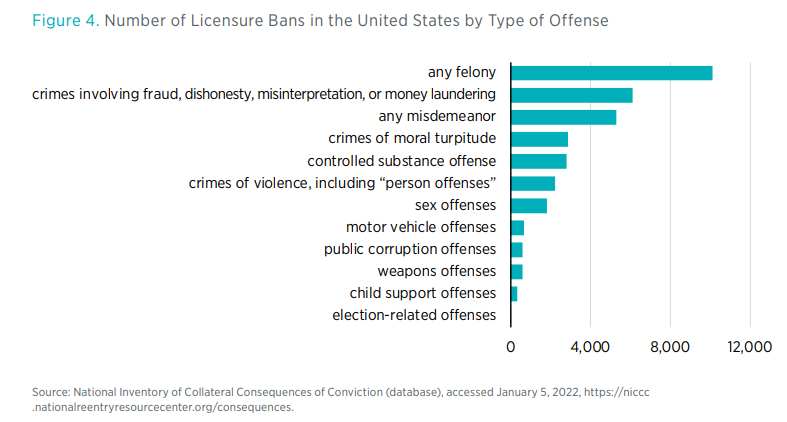
According to a 2021 Institute for Justice report, which provides a state-by-state account of occupational licensing barriers for those with a criminal record, many states today still lack basic protections for ex-offenders who are seeking a license to work. Figures 5 through 8 summarize some of the ways states do—and do not—protect ex-offenders. Figure 5 shows that five states may deny a license for either an irrelevant misdemeanor or an irrelevant felony, and one may deny a license for only an irrelevant felony.
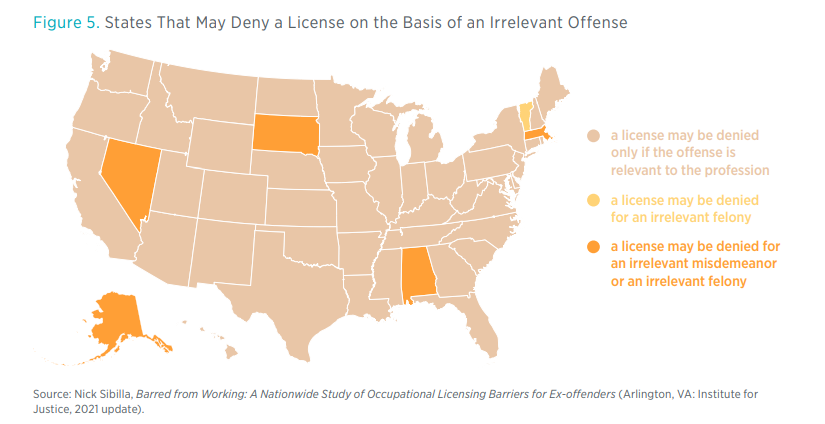
Figure 6 shows that in 14 states, boards are allowed to deny a license without considering whether the applicant has been rehabilitated. Figure 7 shows that in 31 states, a license may be denied on the basis of an arrest that did not lead to a criminal conviction. Figure 8 shows that in 18 states there is no right to appeal a denied license.
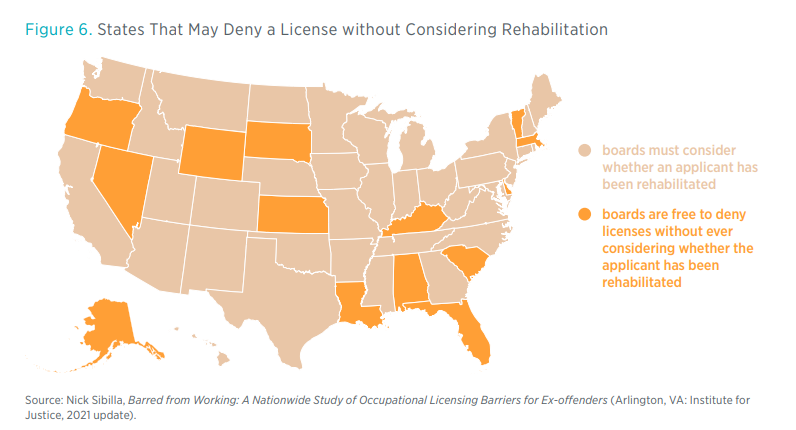

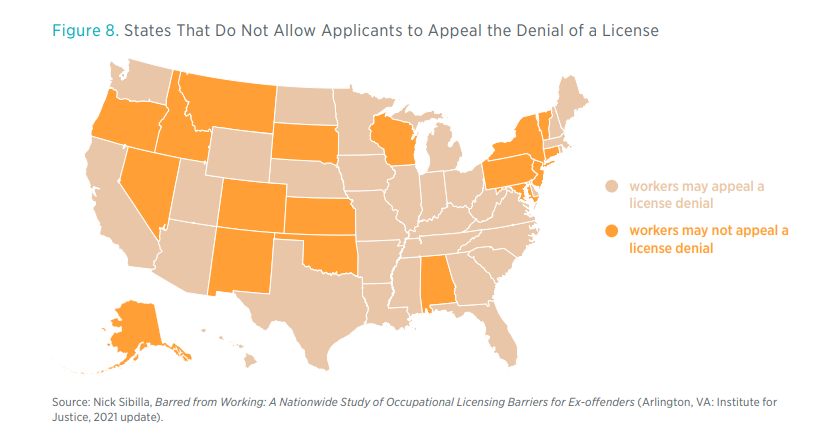
As highlighted in the Institute for Justice report, more than half of US states (33 states) can deny licenses to applicants solely on the basis of arrests, even if an arrest did not lead to a criminal conviction, which means that “boards can refuse to issue a license even though the applicant is functionally innocent.”
What Is the Relationship between Occupational Licensing Restrictions and Recidivism and Crime?
A 2016 study by Stephen Slivinski examines occupational licensing restrictions, including the good-character provisions, across US states from 1997 to 2007. The study finds that, compared with those states with the lowest occupational licensing barriers and no good-character provisions, those states with the heaviest occupational licensing barriers experienced higher average increases in three-year, new-crime recidivism rates. Indeed, states with the highest occupational licensing barriers saw recidivism rates increase by more than 9.0 percent, whereas states with the lowest occupational licensing barriers saw recidivism rates decline by 2.5 percent.
Slivinski’s report complements a large body of research that finds more generally that employment (and earnings) are a significant ingredient in reducing recidivism among the criminal justice population. For example, a 2018 study examines the availability of local jobs in California and finds that better job opportunities in low-skilled industries (such as construction and manufacturing) are associated with lower recidivism rates. A 2020 study also finds that better job opportunities (and media coverage of job creation) in manufacturing reduce recidivism among former inmates. The finding that access to jobs is key to lowering recidivism is consistent across different areas, years, and types of study. One paper concludes, for example, that Black ex-prisoners in Florida being released into counties with lower Black unemployment rates have a decreased likelihood of recidivism.
One sees similar findings in reports that follow specific individuals. For instance, criminologists studied a cohort of 6,561 ex-offenders for five years after release and found that ex-offenders who found employment were significantly less likely to recidivate, regardless of the type of offense committed.
More generally, the research consensus is that better job opportunities, wages, and employment also keep crime rates lower. Even modest improvements in job access can substantially reduce crime, especially drug crime within inner-city neighborhoods. By contrast, more local unemployment is associated with more total crime and more of some specific subcategories of crime, such as burglary, car theft, and bike theft.
Taken together, there is substantial evidence that successful entry into the labor force for the criminal justice population is a key deterrent of recidivism and crime rates. By restricting access to work, occupational licensing for those with criminal histories can thwart the ability of these individuals to reenter the formal economy.
Reforms
Although the US incarceration rate is among the highest in the world, it understates the full economic and personal impact of the US criminal justice system because a period of invisible punishment that begins once one is released from jail or prison ensures, as Jeremy Travis puts it, that “one’s debt to society is never paid.” The restrictions on economic freedom that so often accompany conviction or even arrest cast a long shadow over the lives of those who have been convicted or arrested, limiting those individuals’ ability to work and contribute to society.
Beyond the staggering personal costs for those with criminal records, occupational and business licensing barriers can have negative consequences for states at large because obtaining a job is one of the most important ways that formerly incarcerated individuals can get their lives back in order and avoid returning to prison.
In summary, these occupational licensing restrictions can be counterproductive for states because the restrictions may lead those with criminal records back into unemployment and incarceration. States should consider reforming government-imposed barriers that prevent an individual with a criminal record from reintegrating into the labor force and pursuing an honest living.
State reforms of occupational licensing restrictions for those with a criminal record can begin by targeting five basic, low-hanging-fruit solutions:
- Prohibit agencies from considering arrest records.
- Prohibit agencies from considering old convictions, irrelevant convictions, or expunged records, and require agencies to consider rehabilitation.
- Prevent agencies from using vague standards such as good moral character or moral turpitude.
- Create a petition process, allowing those with criminal records to ask boards before they apply if their records might jeopardize their license. Boards could be required to respond within 30 days.
- Create an appeal process, allowing those who have been denied a license the right to appeal the decision.
Beyond these simple licensing reforms, state policymakers could consider more ambitious criminal justice reforms, such as the following:
- Clean slate, expungement, or rehabilitation certificate laws. Several states have taken steps to wipe individuals’ criminal records clean after specific conditions have been met (for example, staying crime free for 10 years). Michigan, Pennsylvania, and Utah, for instance, have adopted some form of clean slate law or expungement law. Clean slate laws seal criminal records, which means that the vast majority of employers, schools, landlords, and members of the general public do not have access to those records. Expungement of a criminal record differs in that the record is destroyed rather than sealed. Because records are sealed or expunged when individuals have been generally crime free, these laws may not carry the same unintended consequences as ban-the-box policies, which restrict employer access to criminal records of any potential applicant. Ban-the-box policies have been criticized for unintentionally harming racial minorities through statistical discrimination, but we would not expect similar unintended consequences with clean slate or expungement laws. Moreover, rehabilitation certificate laws can also be effective. Although they do not seal or destroy criminal records, they do give individuals an opportunity to obtain a court order declaring that they have been a law-abiding citizen since they were convicted of a crime. Individuals who obtain a rehabilitation certificate send a signal to employers that they are ready for work, trustworthy, and should be deemed less risky for safety or liability reasons. Some preliminary evidence seems to indicate that these types of initiatives (clean slate, expungement, and rehabilitation certificates) are promising solutions for formerly incarcerated individuals.
- Reforming negligent hiring laws. Several studies find that employers are hesitant to hire individuals with a criminal record. One reason that employers, especially small ones, may be hesitant is that the existing legal system can hold employers liable for actions of their employees when the employer knew or should have known about employees’ potential risks. Thus, if a formerly incarcerated individual harms another employee or a third party, the employer could be held liable under negligent hiring laws. These negligent hiring lawsuits have large liability costs and thus make it risky and costly to hire individuals with a criminal record. Some states have already passed laws to reduce the liability of employers for hiring individuals with a criminal record.
- Broader criminal justice reforms. State policymakers could consider a number of broader criminal justice reforms. Although addressing each of these is beyond the scope of this policy brief, there is no shortage of promising proposals, including decriminalization of victimless crimes such as drug crimes, elimination of qualified immunity for police officers, reforms to encourage more jury trials and fewer coerced plea bargains, and relaxation of sentencing guidelines.
Government policies that bar individuals who have had contact with the criminal justice system from access to work encourage poorer outcomes for these individuals and reinforce economic inequality. Even modest reforms in this area can help workers pursue job opportunities and move on a path to a better future.

